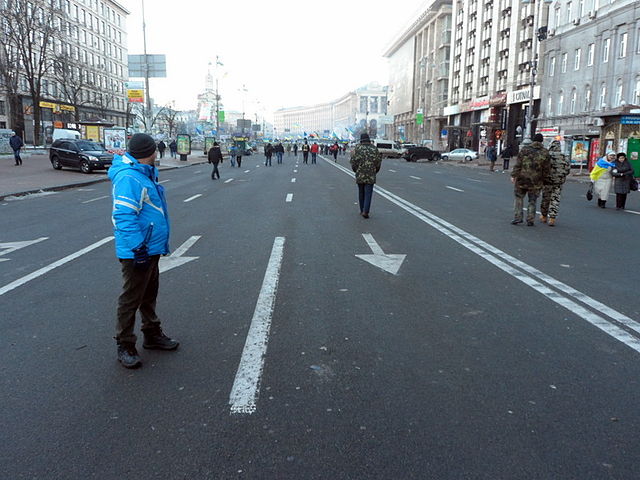The anti-Maidan refers to a number of pro-Russian demonstrations in Ukraine in 2013 and 2014 that were directed against Euromaidan and later the new Ukrainian government. The initial participants were in favor of supporting the cabinet of the second Azarov government, President Viktor Yanukovych, and closer ties with Russia. By the time of the Revolution of Dignity in February 2014, the “anti-Maidan” movement had begun to decline, and after the overthrow of Yanukovych, the anti-Maidan fractured into various other groups, which partially overlapped. These ranged from people protesting against social ills, to supporters of a federalization of Ukraine, to pro-Russian separatists and nationalists.
Anti-Maidan in Kyiv, 14 December 2013
Russian Orthodox Anti-Maidan protesters waving Imperial Russian flags and orthodox banners
Police guard the entrance to the 'Anti-Maidan' demonstration site on European Square, Kyiv, on the morning of 14 December.
The 'corridor' on Khreshchatyk between the Euromaidan and 'Anti-Maidan' demonstrations, looking towards Maidan Nezalezhnosti, 8:00 am, 14 December.
2014 pro-Russian unrest in Ukraine
From the end of February 2014, in the aftermath of the Euromaidan and the Revolution of Dignity, which resulted in the ousting of Russian-leaning Ukrainian President Viktor Yanukovych, demonstrations by Russian-backed, pro-Russian, and anti-government groups took place in major cities across the eastern and southern regions of Ukraine. The unrest, which was supported by Russian military and intelligence, belongs to the early stages of the Russo-Ukrainian War.
Euromaidan demonstration in Kyiv, January 2014
Anti-Maidan in Kyiv, 14 December 2013
Russian "little green men" during the seizure of Perevalne military base, 9 March 2014
Pro-Russian protest in Donetsk, 6 April 2014. Pictured are flags of the Donetsk People's Republic, the Russian Empire, and the Eurasian Youth Union.







